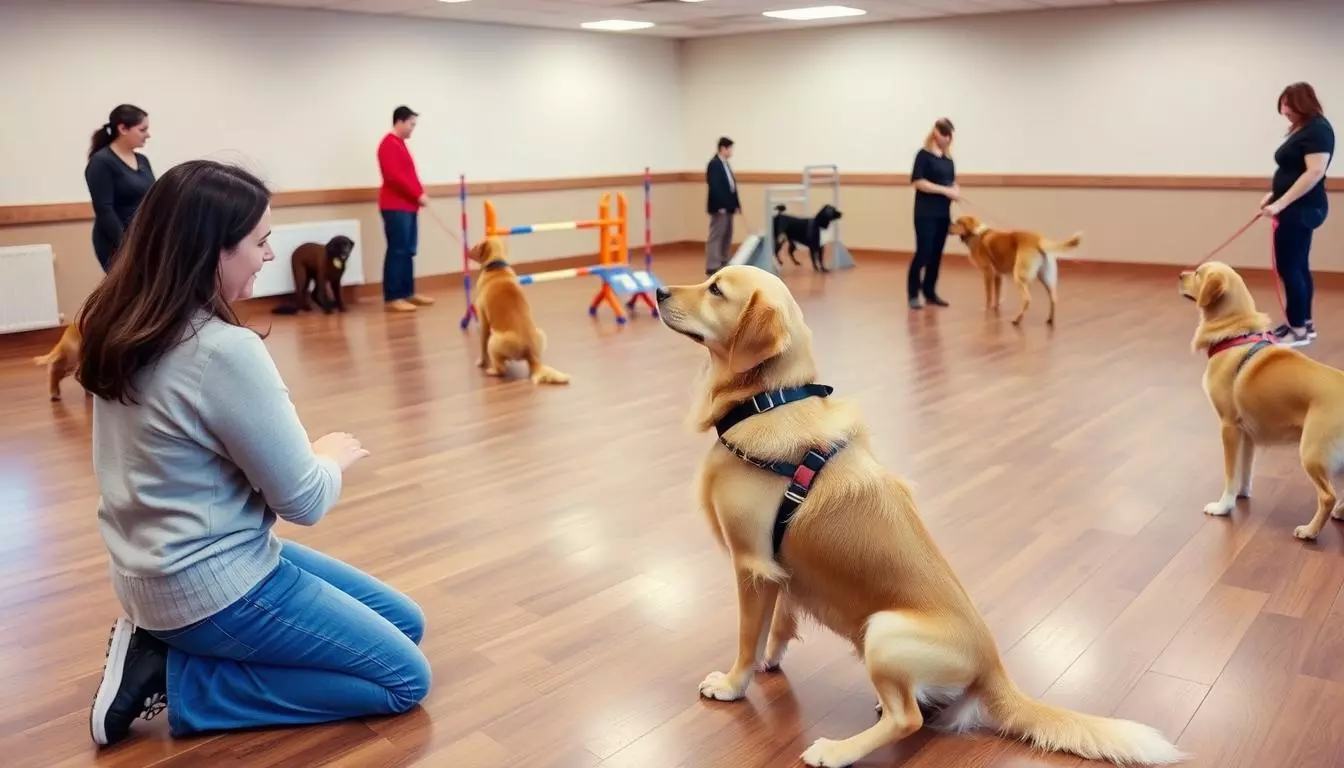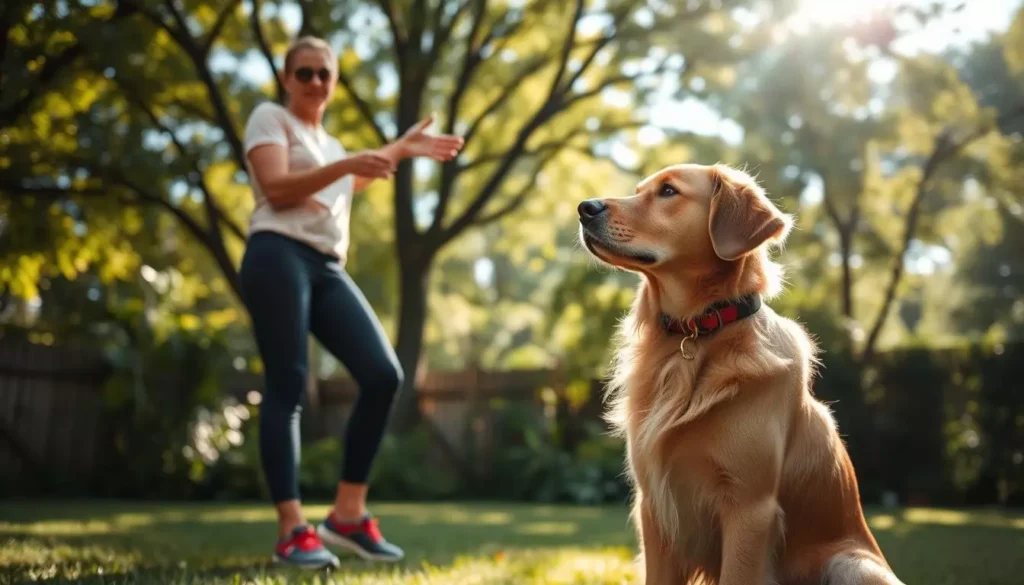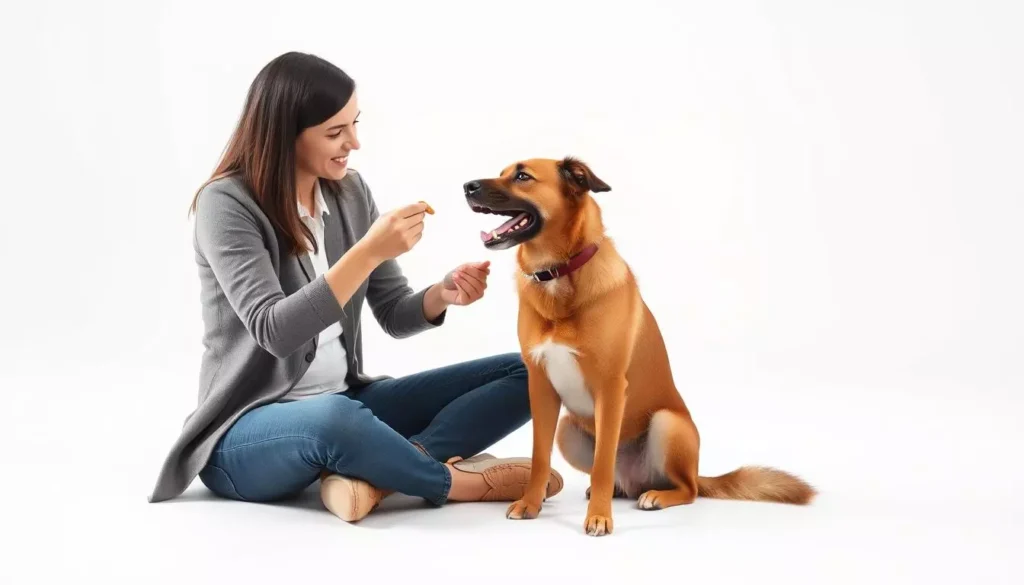As I sit on my porch, watching my dog play, I think about our journey. Teaching him to sit patiently by my side has brought us joy. Our home, once chaotic, is now peaceful, thanks to effective dog training.
This journey has strengthened our bond. I will share techniques that have changed my dog's behavior and deepened our connection. With the right approach, you can enjoy a well-behaved pet, creating lasting memories.
Key Takeaways
- Effective dog training enhances the bond between you and your pet.
- Understanding dog behavior is key to mastering training techniques.
- Positive reinforcement can lead to obedient pets.
- Establishing clear training goals is crucial for success.
- Creating a conducive environment aids in effective dog training.
Understanding Dog Behavior
To be a good trainer, I need to understand dog behavior. Knowing how dogs communicate is key to solving behavioral problems. Dogs use body language, sounds, and scent to talk to each other. By knowing these ways, I can better understand my dog's feelings and actions, making our bond stronger.
Communication Types in Dogs
Dogs have different ways to communicate, showing us their feelings and plans. Here are some important ones:
- Body Language: Tail wagging, ear position, and how they stand can show if they're excited or scared.
- Vocalizations: Barking, growling, or whining can mean they're playful or upset.
- Scent Marking: Dogs use scent to tell others about themselves, their territory, and how they feel.
Common Behavioral Issues
Fixing common behavioral problems needs a good understanding of why they happen. These issues can show up in many ways:
| Behavioral Issue | Description | Potential Solutions |
|---|---|---|
| Barking | Too much barking can come from being anxious or wanting attention. | Use training to focus their attention and reward them for being quiet. |
| Jumping | Jumping on people is often because they're excited or want attention. | Teach them to say 'sit' instead to greet people calmly. |
| Aggression | Aggressive behavior might mean they're scared, defending their space, or frustrated. | Get help from a professional behaviorist for special training and advice. |
| Anxiety | Anxious dogs might act out or not want to play. | Try desensitization methods and give them a safe place to relax. |
Setting Training Goals
Before starting my dog training, setting clear goals is key. SMART goals help make my training more effective. They guide me to reach specific dog obedience goals by focusing on my dog's needs.
SMART Goals for Training Success
SMART means Specific, Measurable, Achievable, Relevant, and Time-bound. It's a great way to set goals for dog training. Here's how:
- Specific: Know what you want to teach, like "sit" on command.
- Measurable: Track progress by counting or timing training sessions.
- Achievable: Start with simple commands that fit your dog's age and breed.
- Relevant: Make sure goals match your dog's needs and improve obedience.
- Time-bound: Set a realistic time frame, like three weeks, to learn a command.
Identifying Your Dog’s Needs
To train effectively, understand your dog's needs. Knowing their breed, energy, and behavior helps tailor your training. For example, high-energy dogs need active training to keep them happy and focused.
| SMART Criteria | Example Goal | Benefit |
|---|---|---|
| Specific | Teaching “stay” command | Improves control |
| Measurable | Practice for 15 minutes, three times a week | Tracks progress |
| Achievable | Starting with basic commands | Boosts confidence |
| Relevant | Aligning goals with my dog's energy | Enhances engagement |
| Time-bound | Achieving target within one month | Encourages focus |
Preparing for Dog Training
Getting ready for dog training is key to success. A good setup can really help your dog learn. A quiet place without distractions helps your dog focus better.
Creating a Conducive Environment
Finding the right spot for training is important. Look for a quiet, calm area away from noise. I like using my living room or a quiet backyard.
This makes my dog feel safe and helps them learn better.
Gathering Essential Training Tools
Having the right tools is crucial for training. You'll need treats, leashes, collars, and clickers. Treats reward your dog, and a good leash keeps them safe.
A clicker helps mark good behavior. I prepare these tools before training to make it smoother.
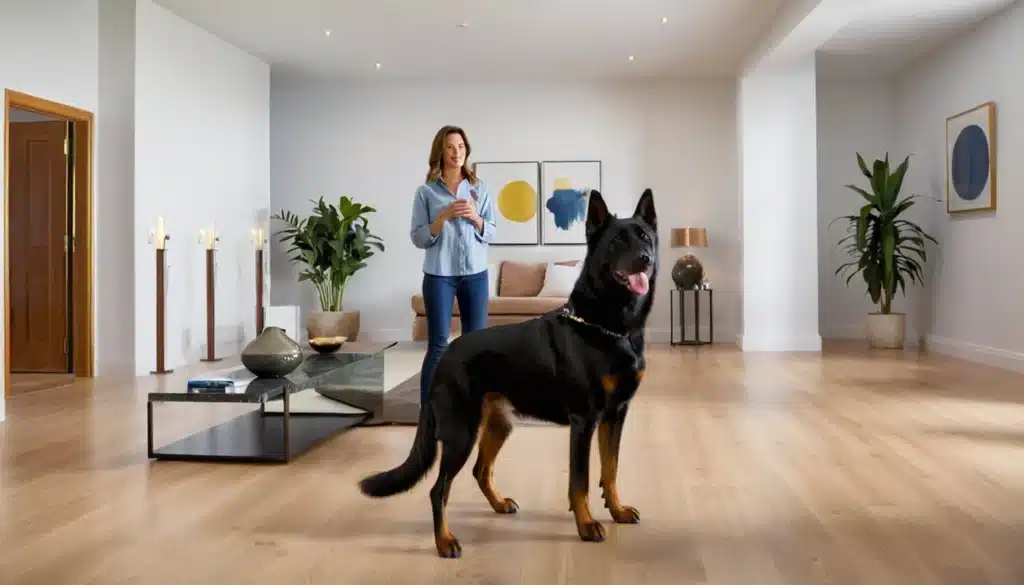
Basic Obedience Commands
Learning basic commands is key for good dog obedience. Commands like ‘sit’, ‘stay’, and ‘come’ help my dog behave well. Each command has its own role, making my dog safer and helping us communicate better.
Using the right teaching methods can really help my dog learn these commands well.
The Importance of ‘Sit’, ‘Stay’, and ‘Come’
The commands ‘sit’, ‘stay’, and ‘come’ are basic in dog training. ‘Sit’ helps me control my dog in different situations. ‘Stay’ teaches my dog to be patient and calm, stopping bad behaviors.
The ‘come’ command is very important. It lets me quickly call my dog back, especially when it's dangerous.
Teaching Techniques for Basic Commands
Using good teaching methods is crucial for learning basic commands. I start with a positive and encouraging tone to boost my dog's confidence. Giving treats as rewards helps my dog learn faster.
Being consistent is also important. I practice regularly so my dog remembers ‘sit’, ‘stay’, and ‘come’. Visual cues can also help, giving my dog more context.
Positive Reinforcement Techniques
Using positive reinforcement in dog training has greatly improved my dog's learning. It strengthens our bond and encourages good behavior. With the right techniques, training becomes a positive and rewarding experience for both of us.
Using Treats and Praise Effectively
Reinforcing with treats and praise makes training better. Giving a treat right after a good action helps my dog learn faster. Praise makes my dog feel loved and appreciated.
Whether it's basic commands or tricks, treats and praise motivate my dog. Here are some effective strategies:
| Reward Type | Benefits | Tips for Usage |
|---|---|---|
| Treats | Increases motivation and excitement | Use small, tasty treats to avoid overfeeding |
| Praise | Builds confidence and strengthens bond | Always use an enthusiastic tone to convey positivity |
| Combining Both | Maximizes learning and effectiveness | Alternate between treats and verbal praise for best results |
Avoiding Punishments in Training
It's important to avoid punishment in training. Negative reinforcement can make my dog scared and anxious. This makes learning harder.
By using positive reinforcement, I help my dog feel safe and confident. My goal is to raise a happy and well-adjusted dog through positive training.
Advanced Training Techniques
Advanced training techniques are key in improving our control and our dog's behavior. Mastering leash training makes walks safer and more enjoyable for both of us. Socialization is also crucial for positive interactions with people, animals, and different places.
Leash Training for Better Control
Effective leash training is vital for control during outings. A well-trained dog walks beside me without pulling. Through consistent practice, my dog learns to follow cues and keep a loose leash, making walks fun.
Key elements of leash training include:
- Using a proper collar or harness for comfort and security
- Practicing “heel” commands to encourage proximity
- Incorporating frequent stops and rewards to reinforce good behavior
Socialization Skills and Their Benefits
Socialization is a key part of advanced training. It shapes my dog's behavior and confidence. By exposing my dog to different situations, I prevent future anxiety or aggression.
Positive socialization experiences help develop essential skills, including:
- Reduced fear and anxiety in novel situations
- Improved interaction with other dogs and humans
- Enhanced ability to adapt to new experiences
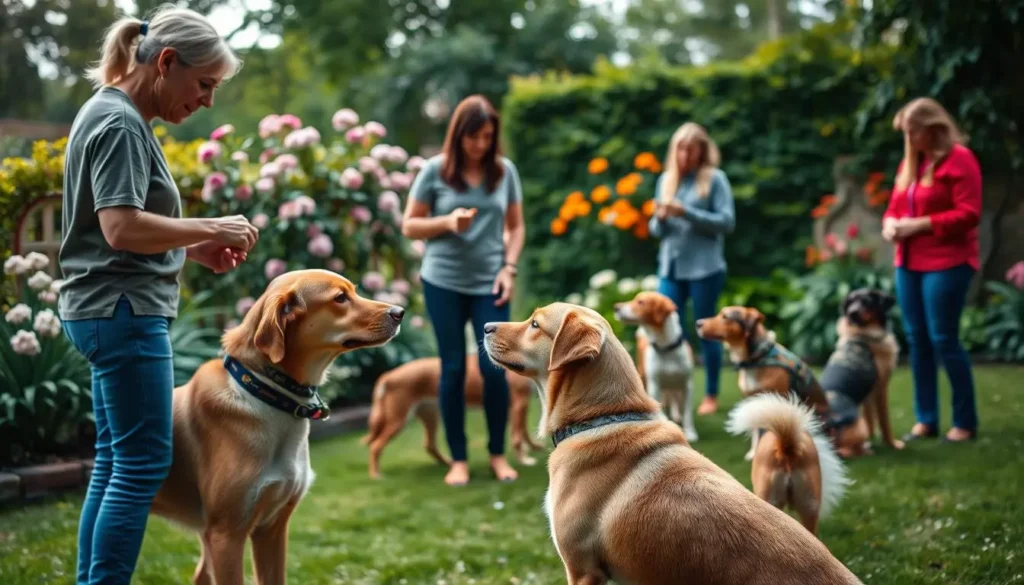
Incorporating Distractions into Training
Adding distractions to my dog's training is key for reliable responses. It helps build focus and improves obedience. I start in controlled areas, then add more distractions as my dog gets better.
This way, my dog learns well and gets ready for real-life challenges.
Gradually Introducing Distractions
Starting with small distractions is best. I might use sounds like tapping or clapping first. Then, I add visual distractions, like moving objects or another dog.
This slow introduction helps my dog stay focused and learn to obey commands, even with distractions.
Real-Life Situations for Effective Learning
Training in real-life settings is very valuable. Parks and busy streets are great for testing my dog's skills. These places offer genuine distractions.
Training in these environments helps my dog learn to stay calm and respond well, no matter what's happening around them.
Maintaining Consistency in Training
Getting your dog to learn well depends on keeping training consistent. Setting up routines helps my dog know what's expected of them. This makes learning easier and helps them pick up skills faster.
Establishing Routines for Success
To help my dog learn, I create clear routines. This means:
- Setting specific times for training each day
- Using the same commands every time to avoid confusion
- Always rewarding good behavior to help them understand
These steps help make learning easier for my dog. When routines are clear, they feel more secure and focused. This leads to better results in training.
Common Challenges in Dog Training
Dog training can face many hurdles, mainly due to distractions or aggression. Spotting these issues early helps me tackle them head-on. To manage distractions, I start in a place my dog knows well. Then, I slowly add outside elements to keep them focused.
Dealing with Distractions
Distractions can ruin even the best training sessions. I begin in a quiet area and add more distractions as my dog gets better. This way, my dog learns to ignore distractions and stay focused.
Handling Aggressive Behaviors
Dealing with aggression requires professional help. I use positive reinforcement to change my dog's behavior. I reward calm actions and discourage aggression through consistent training. This method improves behavior and strengthens our bond.
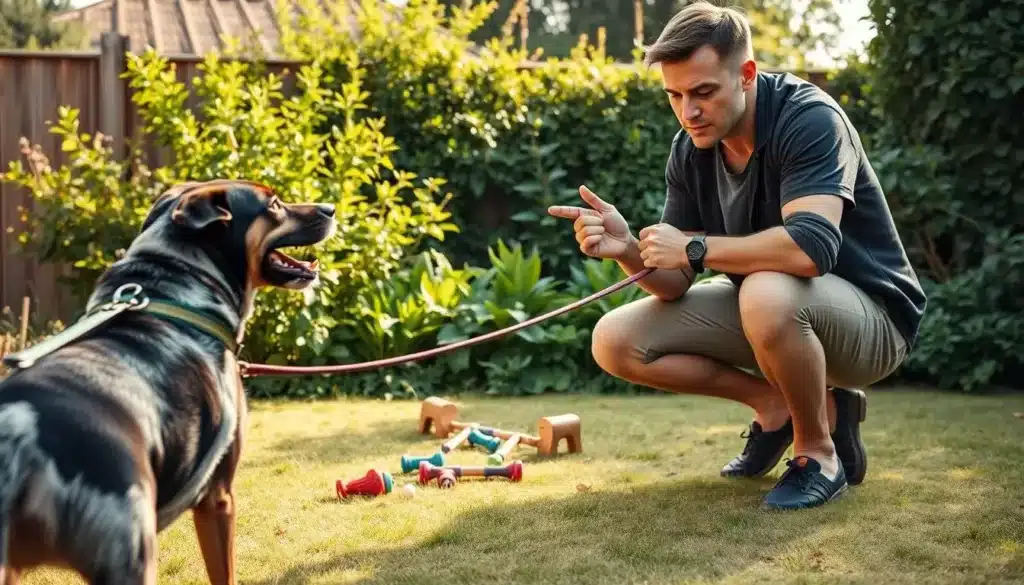
Advanced Techniques for Off-Leash Control
Teaching your dog to be off-leash is very rewarding. It lets them have freedom while keeping them safe. It also makes you feel more at ease. To do this, you need to focus on recall and setting boundaries.
Building these skills takes time and effort. But it's worth it for the bond you'll share with your dog.
Training for Reliable Recall
Recall is key to off-leash control. I teach my dog to come back when called, using a whistle or a command. I start in a quiet place with few distractions.
Then, I add more distractions and move further away. This way, my dog learns to come back fast. It strengthens our trust and connection.
Controlled Releases and Boundaries
Setting clear rules is important for off-leash freedom. I teach my dog when it's okay to run around. This helps them understand what's expected.
Boundaries are also crucial. They keep my dog safe and let them explore. These boundaries can be physical or just a rule. They help my dog stay away from dangers while still enjoying their freedom.
The Role of Socialization in Dog Training
Socialization is key in dog training. It shapes a dog's behavior and adaptability. Early exposure to different settings and people helps them adjust well.
By making these experiences positive, I prepare my dogs for a happy life. They learn to behave well in various situations.
Importance of Early Exposure
Puppies are very open to new experiences. They learn a lot from social interactions. This helps prevent future behavioral problems.
It builds their confidence and reduces fear. Puppies that meet many people and dogs grow into well-adjusted adults.
Creating Positive Experiences
Positive experiences are crucial in socialization. I make sure every interaction with my dog is enjoyable. This approach helps them understand and adopt good behavior.
By doing this, I create a positive association with new things. It lays the groundwork for their social skills for life.
Using Aversives Correctly
Aversives in dog training have a clear purpose. They can help stop unwanted behaviors when used wisely. But, it's crucial to avoid hurting the dog's feelings. Knowing when to use aversives is key to good training.
Understanding Aversives in Training
The use of aversives in training is a topic of debate. Aversives are uncomfortable stimuli for unwanted behaviors. Examples include:
- Verbal reprimands
- Leash corrections
- Shock collars
It's important to balance aversives with positive reinforcement. This approach helps dogs learn right from wrong. It makes training more effective and kinder.
Watching how a dog reacts to aversives is vital. Each dog is unique, and what works for one might stress another. A good training plan mixes strategies that care for the dog's feelings and teach well.
Enhancing the Bond with Your Dog
Building a strong connection with my dog is key to effective training. A solid bond comes from regular, positive interactions. Patience helps build trust, which improves our communication.
This trust leads to mutual respect. This makes our training sessions more effective.
Building Trust and Respect
Trust is essential. It takes ongoing effort and positive rewards during training. Positive reinforcement makes my dog want to participate, strengthening our bond.
Practicing commands in a calm place boosts confidence. This creates a great learning environment.
Respect goes both ways. I need to understand my dog and communicate clearly. Recognizing their limits and celebrating their wins strengthens our bond.
This mix of trust and respect makes my dog perform better. It improves our training experience together.
Evaluating Progress in Dog Training
Starting dog training is exciting, but checking progress is key. It helps me see if what I'm doing is working. I learn to change my approach if needed. Being consistent is very important in teaching my dog new things.
Why Consistency Matters
Having regular training sessions helps a lot. It makes my dog know what to do and when. This predictability helps them learn faster and respond better.
Seeing my dog get better over time is rewarding. It shows that the training is paying off. Sticking to a routine makes my dog more obedient and happy.
Recognizing Signs of Progress
Seeing small changes in my dog's behavior is exciting. Like when they learn commands faster or feel less scared. It means they're getting it.
When my dog gets more into training, it's a sign they're feeling more confident. These small signs help me know I'm on the right track. It also makes our bond stronger.
| Behavioral Sign | Description | Significance |
|---|---|---|
| Improved Response Time | My dog responds quicker to commands. | Indicates better understanding of commands. |
| Decreased Anxiety | My dog shows less fear in new situations. | Suggests increased confidence and comfort. |
| Increased Engagement | My dog participates actively in training sessions. | Shows eagerness to learn and connect. |
Finding the Right Training Method
Choosing the right training method is key for my dog's learning journey. I focus on evaluating training methods to find what works best. I also consider my dog's personality and what he likes.
Evaluating Popular Training Techniques
There are many training methods out there, each with its own benefits. Positive reinforcement and clicker training are two popular ones. Positive reinforcement rewards my dog for good behavior, building a strong bond. Clicker training uses sounds to clearly mark actions, helping my dog learn fast.
| Training Method | Focus | Best for |
|---|---|---|
| Positive Reinforcement | Reward good behavior | All dogs, especially those motivated by treats |
| Clicker Training | Sound cues for specific actions | Dogs that respond well to auditory signals |
| Dominance Theory | Establishing hierarchy | Not recommended; can create fear |
Understanding Your Dog’s Learning Style
Dogs learn in different ways, affecting their training. Some dogs do better with visual cues, while others prefer sounds. Knowing these styles helps me tailor training to fit my dog's needs.
Watching my dog during training gives me clues. Does he like hands-on help or verbal praise? Knowing these helps me create a training plan that works for him.
Conclusion
Mastering dog training is a lifelong journey that needs patience and dedication. I've learned that understanding my dog's behavior is key. This helps me use effective training techniques.
Using positive reinforcement and being consistent helps my dog learn better. It creates a great environment for pet obedience to grow.
This journey not only improves my dog's behavior but also strengthens our bond. It makes our relationship more fulfilling. As I keep learning and improving, I understand the true meaning of mastering dog training.
Sticking with this process leads to long-term success and happiness. With hard work and the right attitude, making my pet obedient becomes a rewarding experience.

